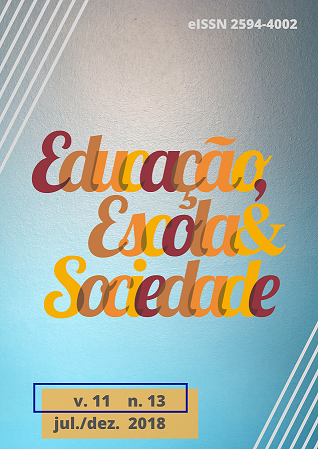Sólidos geométricos por meio de material manipulável: um recurso para o ensino de Geometria
Resumo
Este artigo aborda uma atividade desenvolvida por bolsistas do Pibid com alunos do 5º ano do Ensino Fundamental de uma escola pública do município de Salinas-MG. Atividade desenvolvida em apoio a professores que buscavam a iniciação dos alunos no estudo de Geometria. Assim, desenvolveu-se uma oficina com a temática: Montando Sólidos Geométricos. Nessa atividade os alunos construíram os sólidos geométricos com a manipulação de materiais, simultaneamente ao estudo dos sólidos trabalhados. Tudo em constante monitoramento por parte dos professores e bolsistas, validando os acertos e destacando os erros, e desta forma, ajudando os alunos a reformular concepções e contornar as dificuldades apresentadas na aprendizagem da Geometria. Mostrou ainda o quanto a Matemática é presente no cotidiano e interessante de ser aprendida. Serviu também para mostrar que se o material manipulável for bem utilizado poderá se tornar uma importante ferramenta para auxiliar no ensino da Geometria.
Palavras-chave: Ensino de Geometria. Material Manipulável. PIBID.
Downloads
Referências
BICUDO, Maria Aparecida Viggiani. Educação Matemática. 2 ed. São Paulo, SP: Centauro, 2005.
BRASIL, Parâmetros curriculares nacionais: matemática/Secretariade Educação Fundamental. – Brasília: MEC/SEF, 1998.
BRASIL, Parâmetros curriculares nacionais: matemática/Secretaria de Educação Fundamental. – Brasília: MEC/SEF, 1997.
BRASIL, Portaria nº 096, de 18 de Julho de 2013. Institui novo Regulamento do Pibid.
DANTE, Luiz Roberto. Didática da Resolução de Problemas de Matemática. 12. edição. São Paulo, 2005.
FIORENTINI, Dario; MIORIM, Maria Ângela. Uma reflexão sobre o uso de materiais concretos e jogos no Ensino da Matemática. Boletim da SBEM. SBEM: São Paulo, ano 4, n. 7, 1990.
LORENZATO, Sergio. Laboratório de ensino de matemática e materiais didáticos manipuláveis. In: LORENZATO, Sérgio. Laboratório de Ensino de Matemática na formação de professores. Campinas: Autores Associados, 2006, p. 3-38.
LORENZATO, Sergio. Educação infantil e percepção matemática. 2. ed. Campinas, SP: Autores Associados, 2008.
OTTESBACH, R. C.; PAVANELLO, R. M. Laboratório de Ensino e Aprendizagem daMatemática na apreciação de professores. 2009.
PELIZZARI, Adriana. et al. Teoria da aprendizagem significativa segundo Ausubel. Disponível em <http://portaldoprofessor.mec.gov.br/storage/materiais/0000012381.pdf> Acesso em: 29 abr 2014.
RÊGO, R. M.; RÊGO, R. G. Desenvolvimento e uso de materiais didáticos no ensino de matemática. In: LORENZATO, Sérgio. Laboratório de Ensino de Matemática na formação de professores. Campinas: Autores Associados, 2006. p. 39-56
ROSA, Sanny S. da. Construtivismo e Mudança. 4ª. Edição. São Paulo: Editora Cortez, 1996.
SERRAZINA, M. L. Os materiais e o ensino da Matemática. Educação e Matemática, n. 13, jan/mar., 1990. (Editorial).
SILVA, A.; MARTINS, S. Falar de Matemática hoje é .... Millenium – Revista do ISPV: Instituto Superior Politécnico de Viseu, sem, n. 20, out de 2000.
SCOLARO, Maria A. O uso dos Materiais Didáticos Manipuláveis como recurso pedagógico nas aulas de Matemática.
TURRIONI, Ana Maria Silveira. O Laboratório de Educação Matemática na formação inicial de professores. 2004. 175f. Dissertação (Mestrado em Educação Matemática) – Instituto de Geociências e Ciências Exatas, Universidade Estadual Paulista (UNESP), Rio Claro, 2004.














